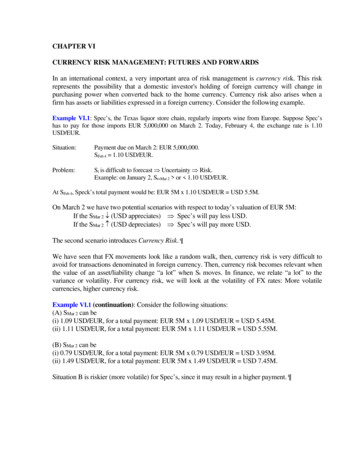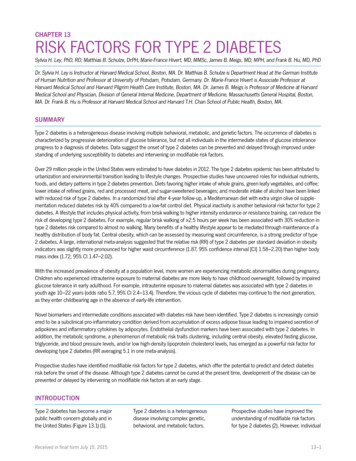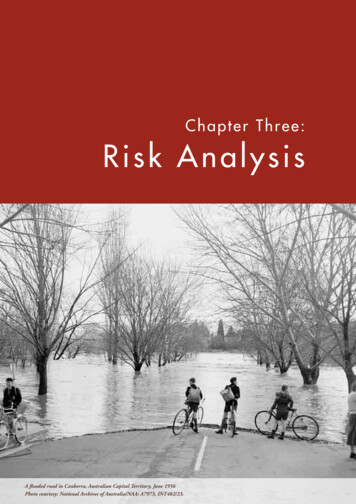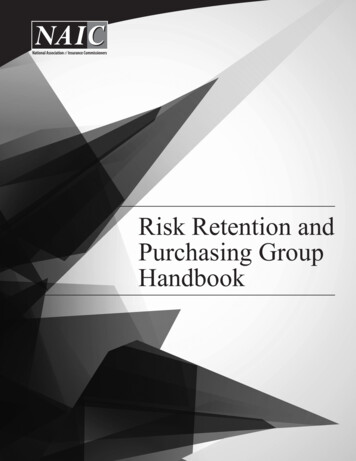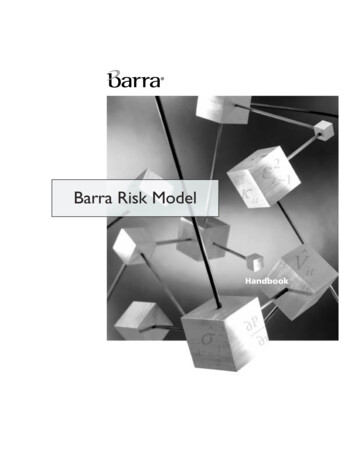
Transcription
Centers for Medicare & Medicaid ServicesInformation Security and Privacy GroupRisk Management Handbook (RMH)Chapter 14: Risk Assessment (RA)Version 1.1October 19, 2018
Centers for Medicare & Medicaid ServicesRecord of ChangesThe “Record of Changes” table below capture changes when updating the document. Allcolumns are mandatory.VersionNumberDateChapter SectionAuthor/OwnerNameDescription of Change0.111/29/2017AllISPGInitial Draft0.201/03/2018AllISPGWorking Group Review0.303/09/2018Section 3.3ISPGAlignment with new HHS PGUpdate to new RMH template;inclusion of latest RiskAssessment-related audit findingsand POA&MsPublication1.110/19/2018Section 6.2.3ISPGRisk Management Handbook (RMH) Chapter 14: Risk Assessment(RA)Version 1.0Update to guidance on SSP fromNIST publication 800-18 to RMHChapter 12 Security and PrivacyPlanning.iiOctober 19, 2018
Centers for Medicare & Medicaid ServicesEffective Date/ApprovalThis Procedure becomes effective on the date that CMS’s Deputy Chief Information SecurityOfficer signs it and remains in effect until it is rescinded, modified or superseded.Signature:/s/Date ofIssuanceKevin Allen DorseyCMS Deputy Chief Information Security Officer(DCISO)Risk Management Handbook (RMH) Chapter 14: Risk Assessment(RA)Version 1.0iii
Centers for Medicare & Medicaid ServicesTable of ContentsEffective Date/Approval . iii1. Introduction . 61.11.21.31.4Purpose .6Authority .6Scope .7Background .72. Policy . 92.12.2Information Systems Security and Privacy Policy (IS2P2).9Chief Information Officer (CIO) Directives .93. Standards . 93.1Acceptable Risk Safeguards (ARS) .104. HIPAA Integration . 105. Roles and Responsibilities . 116. Procedures . 126.16.26.3Security Categorization (RA-2) .12Risk Assessment (RA-3) .15Basic Risk Management .15Risk Models .17High Value Assets .19Vulnerability Scanning (RA-5) .32Update Tool Capability (RA-5(1)) .35Update Frequency/Prior to New Scan/When Identified (RA-5(2)) .36Discoverable Information (RA-5(4)) .36Privileged Access (RA-5(5)) .37Appendix A. Acronyms . 38Appendix B. Glossary of Terms . 42Appendix C. Applicable Laws and Guidance . 55Appendix D. Information System Risk Assessment (ISRA) Template. 59Appendix E. CMS Information Security Policy/Standard Risk AcceptanceTemplate . 60Risk Management Handbook (RMH) Chapter 14: Risk Assessment(RA)Version 1.0iv
Centers for Medicare & Medicaid ServicesAppendix F: Feedback and Questions . 61Appendix G. Plan of Action and Milestones (POA&M) Guide . 62TablesTable 1: CMS Information Types . 13Table 2: Summary of Risk Assessment Tasks . 21Table 3: CMS Defined Parameters - Control RA-3 . 25Table 4: CMS Defined Parameters – Control RA-5 . 34Table 5: CMS Defined Parameters – Control RA-5(2) . 36Table 6: CMS Defined Parameters – Control RA-5(4) . 37Table 7: CMS Defined Parameters – Control RA-5(5) . 37FiguresFigure 1: Categorization of Federal Information and Information Systems . 13Figure 2: Risk Assessment within the Risk Management Process . 16Figure 3: Tiered Risk Management Approach. 17Figure 4: Generic Risk Model with Key Risk Factors . 18Figure 5: Agency HVA Process Framework . 19Figure 6: Risk Assessment Process. 21Figure 7: Risk Executive (Function) . 24Risk Management Handbook (RMH) Chapter 14: Risk Assessment(RA)Version 1.0v
Centers for Medicare & Medicaid ServicesIntroduction1. Introduction1.1PurposeThe Centers for Medicare & Medicaid Services (CMS) Risk Management Handbook (RMH)Chapter 14 Risk Assessment provides the procedures for implementing the requirements of theCMS Information Systems Security and Privacy Policy (IS2P2) and the CMS Acceptable RiskSafeguards (ARS). The following is a diagram that breaks down the hierarchy of the IS2P2, ARS,and RMH:This document describes procedures that facilitate the implementation of security controlsassociated with the Risk Assessment (RA) family of controls. To promote consistency among allRMH Chapters, CMS intends for Chapter 14 to align with guidance from the National Institute ofStandards and Technology (NIST). CMS incorporates the content of NIST’s Special Publication(SP) 800-53, Security and Privacy Controls for Federal Information Systems and Organizations;and NIST SP 800-137 Information Security Continuous Monitoring (ISCM) for FederalInformation Systems and Organizations, into its governance documents, tailoring that content tothe CMS environment.1.2AuthorityThe Federal Information Security Management Act (FISMA) requires each federal agency todevelop, document and implement an agency-wide program to provide information security forthe information and systems that support the operations and assets of the agency, including thoseprovided or managed by another agency or contractor. The Federal Information SecurityModernization Act of 2014 designates NIST with responsibility to develop guidance to federalagencies on information security and privacy requirements for federal information systems.Risk Management Handbook (RMH) Chapter 14: Risk Assessment(RA)Version 1.06
Centers for Medicare & Medicaid ServicesIntroductionAs an operating division of the Department of Health and Human Services (HHS), CMS must alsocomply with the HHS IS2P, Privacy Act of 1974 (“Privacy Act”), the Privacy and Security Rulesdeveloped pursuant to the Health Insurance Portability and Accountability Act of 1996 (HIPAA),and the E-Government Act of 2002, which relates specifically to electronic authenticationrequirements. The HHS Office for Civil Rights (OCR) is responsible for enforcement of theHIPAA Security and Privacy Rules. CMS seeks to comply with the requirements of theseauthorities, and to specify how CMS implements compliance in the CMS IS2P2.HHS and CMS governance documents establish roles and responsibilities for addressing privacyand security requirements. In compliance with the HHS Information Systems Security and PrivacyPolicy (IS2P), the CMS Chief Information Officer (CIO) designates the CMS Chief InformationSecurity Officer (CISO) as the CMS authority for implementing the CMS-wide informationsecurity program. HHS also designates the CMS Senior Official for Privacy (SOP) as the CMSauthority for implementing the CMS-wide privacy program. Through their authority given byHHS, the CIO and SOP delegate authority and responsibility to specific organizations and officialswithin CMS to develop and administer defined aspects of the CMS Information Security andPrivacy Program.All CMS stakeholders must comply with and support the policies and the procedures referencedin this handbook to ensure compliance with federal requirements for implementation ofinformation security and privacy controls.1.3ScopeThis handbook documents procedures that facilitate the implementation of the privacy and securitycontrols defined in the CMS IS2P2 and the CMS ARS. This RMH Chapter provides authoritativeguidance on matters related to the Risk Assessment family of controls for use by CMS employeesand contractors that support the development, operations, maintenance, and disposal of CMSinformation systems. This handbook does not supersede any applicable laws, existing labormanagement agreements, and/or higher-level agency directives or other governance documents.1.4BackgroundThis handbook aligns with NIST SP 800-53 catalogue of controls, the CMS IS2P2, and the CMSARS. Each procedure relates to a specific NIST security control family. Additional sections of thisdocument crosswalk requirements to other control families and address specific audit requirementsissued by various sources (e.g., OMB, OIG, HHS, etc.).RMH Chapter 14 provides processes and procedures to assist with the consistent implementationof the RA family of controls for any system that stores, processes, or transmits CMS informationon behalf of CMS. This chapter identifies the policies, minimum standards, and procedures for theeffective implementation of selected security and privacy controls and control enhancements inthe RA family.CMS’s comprehensive information security and privacy policy framework includes:Risk Management Handbook (RMH) Chapter 14: Risk Assessment(RA)Version 1.07
Centers for Medicare & Medicaid Services IntroductionAn overarching policy (CMS IS2P2) that provides the foundation for the security andprivacy principles and establishes the enforcement of rules that will govern the programand form the basis of the risk management frameworkStandards and guidelines (CMS ARS) that address specific information security andprivacy requirementsProcedures (RMH series) that assist in the implementation of the required security andprivacy controls based upon the CMS ARS standards.FISMA further emphasizes the importance of continuously monitoring information systemsecurity by requiring agencies to conduct assessments of security controls at a risk-definedfrequency. NIST SP 800-53 states under the RA control family that an organization must define,develop, disseminate, review, and update its Risk Assessment documentation at least once everythree years. This includes a formal, documented system security package that addresses purpose,scope, roles, responsibilities, management commitment, coordination among organizationalentities, and compliance; and formal, documented processes and procedures to facilitate theimplementation of the Risk Assessment policy and associated controls.The Risk Assessment process exists within the Risk Management Framework (RMF) whichemphasizes: Building information security capabilities into federal information systems through theapplication of state-of-the-practice management, operational, and technical securitycontrolsMaintaining awareness of the security state of information systems on an ongoing basisthough enhanced monitoring processesProviding essential information to senior leaders to facilitate decisions regarding themitigation or acceptance of information-systems-related risk to organizational operationsand assets, individuals, external organizations, and the Nation.The RMF 1 has the following characteristics: 1Promotes the concept of near-real-time risk management and ongoing-information-systemauthorization through the implementation of robust continuous monitoring processes;Encourages the use of automation to provide senior leaders the necessary information tomake cost-effective, risk-based decisions with regard to the organizational informationsystems supporting their core missions and business functions;Integrates information security and privacy protections into the enterprise architecture andeXpedited Life Cycle (XLC);Provides guidance on the selection, implementation, assessment, and monitoring ofcontrols and the authorization of information systems;Links risk management processes at the information system level to risk managementprocesses at the organization level through a risk executive (function); andEstablishes responsibility and accountability for security and privacy controls deployedwithin organizational information systems and inherited by those systems (i.e., /detail/sp/800-37/rev-1/finalRisk Management Handbook (RMH) Chapter 14: Risk Assessment(RA)Version 1.08
Centers for Medicare & Medicaid ServicesPolicy2. PolicyPolicy delineates the security management structure, clearly assigns security responsibilities, andlays the foundation necessary to reliably measure progress, compliance, and direction to all CMSemployees, contractors, and any individual who receives authorization to access CMS informationtechnology (IT) systems or systems maintained on behalf of CMS to assure the confidentiality,integrity, and availability of CMS information and information systems.2.1Information Systems Security and Privacy Policy (IS2P2)The CMS IS2P2 2 defines the framework and policy under which CMS protects and controls accessto CMS information and information systems in compliance with HHS policy, federal law, andregulations. This Policy requires all CMS stakeholders to implement adequate information securityand privacy safeguards to protect all CMS sensitive information.The policy contained within the CMS IS2P2 and the procedures contained within this documentassist in satisfying the requirements for controls that require CMS to create a policy and associatedprocedures related to Risk Assessment for information systems.2.2Chief Information Officer (CIO) DirectivesThe CMS Chief Information Officer (CIO), the CMS Chief Information Security Officer (CISO),and the CMS Senior Official for Privacy (SOP) jointly develop and maintain the CMS IS2P2. TheCIO delegates authority and responsibility to specific organizations and officials within CMS todevelop and administer defined aspects of the CMS Information Security and Privacy Program asappropriate.The dynamic nature of information security and privacy disciplines and the constant need forassessing risk across the CMS environment can cause gaps in policy, to arise outside of the policyreview cycle. The CMS Policy Framework includes the option to issue a CIO Directive 3 to addressidentified gaps in CMS policy and instruction to provide immediate guidance to CMS stakeholderswhile a policy is being developed, updated, cleared, and approved.3. StandardsStandards define both functional and assurance requirements within the CMS security and privacyenvironment. CMS policy is executed with the objective of enabling consistency across the CMSenvironment. The CMS environment includes users, networks, devices, all software, processes,information in storage or transit, applications, services, and systems that can be connected directlyor indirectly to networks. These components are responsible for meeting and complying with age 1&DLEntries 10&DLFilter is2&DLSort 0&DLSortDir ascending3 ndPolicies/Policies.htmlRisk Management Handbook (RMH) Chapter 14: Risk Assessment(RA)Version 1.09
Centers for Medicare & Medicaid ServicesHIPAA Integrationsecurity and privacy baseline defined in policy and further prescribed in standards. The parametersand thresholds for policy implementation are built into the CMS standards, and provide afoundation for the procedural guidance provided by the Risk Management Handbook series.3.1Acceptable Risk Safeguards (ARS)The CMS Acceptable Risk Safeguards (ARS) 4 provides guidance to CMS and its contractors as tothe minimum acceptable level of required security and privacy controls that must be implementedto protect CMS’s information and information systems, including CMS sensitive information. Theinitial selection of the appropriate controls is based on control baselines. The initial controlbaseline is the minimum list of controls required for safeguarding an IT system based on theorganizationally identified needs for confidentiality, integrity, and/or availability.A different baseline exists for each security category (high, moderate, low) as defined by NISTFederal Information Processing Standards (FIPS) 199, Standards for Security Categorization ofFederal Information and Information Systems. The ARS provides a catalog of low, moderate,and high controls, in addition to non-mandatory controls outside of the FIPS-199 baselineselection. The ARS, based upon the FIPS 200 and NIST SP 800-53, provides guidance ontailoring controls and enhancements for specific types of missions and business functions,technologies, or environments of operation. Users of the ARS may tailor specific mandatorycontrols as well as most of the non-mandatory and unselected controls.4. HIPAA IntegrationThe HIPAA Security Rule is designed to be flexible, scalable, and technology-neutral, whichenables it to be adaptive and seamlessly integrate with detailed frameworks such as FISMA.Though both regulations are governed by different federal agencies, the HIPAA Security Rule onlyapplies to covered entities and their business associates as defined within HIPAA. Implementationof the FISMA requirements helps achieve compliance with the HIPAA Security Rule. HIPAAprovide
0.3 03/09/2018 Section 3.3 ISPG Alignment with new HHS POAM Guidance 0.4 08/15/2018 All ISPG Update to new RMH template; inclusion of latest Risk Assessment-related audit findings and POA&Ms 1.0 10/01/2018 All ISPG Publication 1.1 10/19/2018 Section 6.2.3 ISPG Update to guidance on SSP from . Risk Manage
